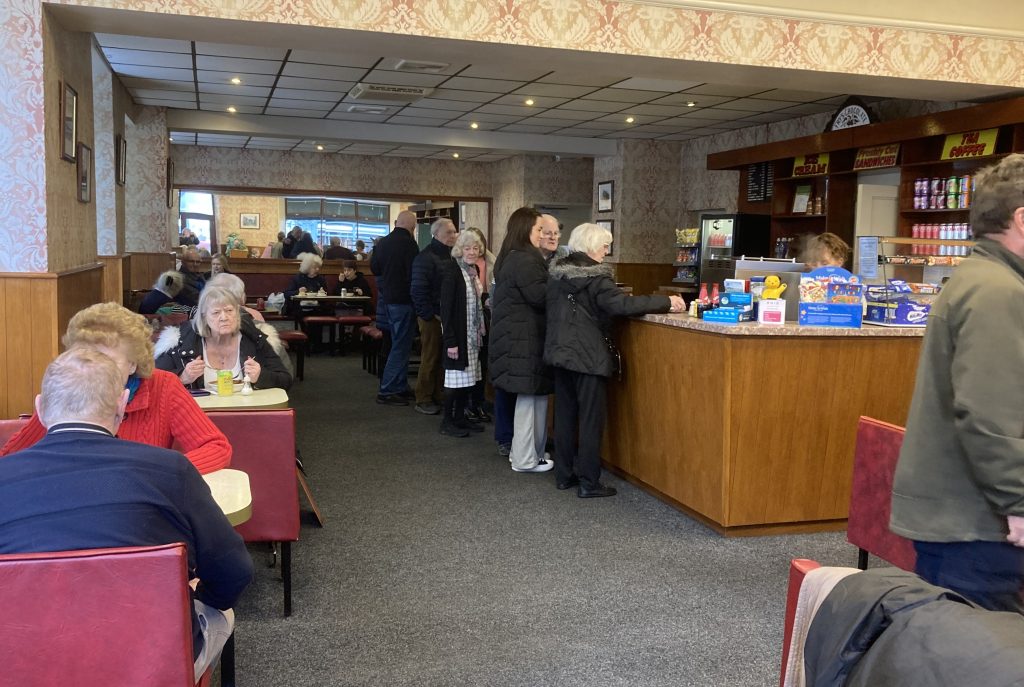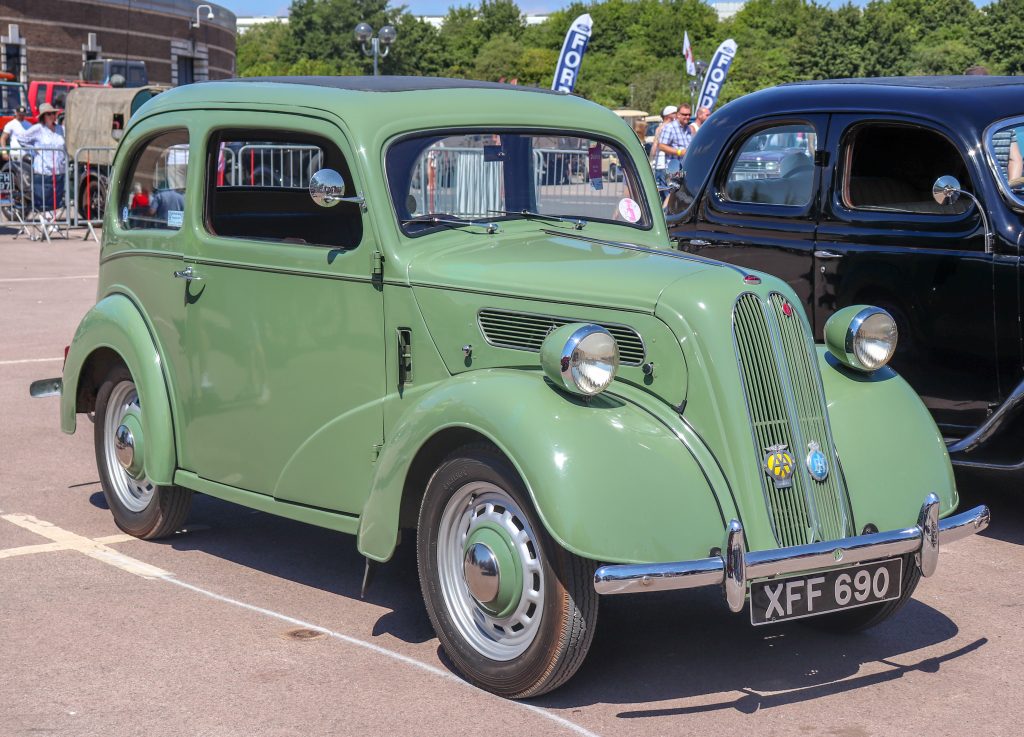NO ONE could accuse Clitheroe, our nearby market town, of being trendy, and that’s the way we like it. To prove it, just about the most popular place is a café which could be a time capsule from 50 years ago. It’s officially called Colborne House Café but everyone calls it Swales after the family who have owned it for donkey’s years. It’s distinctly unassuming from the outside.

I love this side wall – there isn’t much you can’t get here.

It’s just as unassuming inside. This was at 12.05pm and already it was nearly full. (There are a lot more seats than in this picture, I would guess around 80.)

The seats are red vinyl, the tables are Formica, the ceiling is those old-style polystyrene tiles and the counter is wood-effect.
We first visited ten years ago or more, but thanks to this and that we didn’t get there again until about six months ago. As soon as we sat down, a friendly waitress came over and asked if we had been before because she wanted to show us the ropes. When we told her, she said: ‘Well, you’ll find there’ve been some big changes since then. We’ve added jackets and toasties to the menu.’

Last week we went again to meet a couple of friends. The system is that you pick up a tray and queue at the counter to place your order.

Tea and coffee are served straight away and you carry the drinks and cutlery to your table. Note that a spare saucer is supplied for your teabags.

Your meals are brought by one of the lovely waitresses. They work so hard but they have a word for everyone – in fact I’m sure they know most of their customers by name. Look at those slices of bread!

The staple of the café is pies: meat, meat and potato, steak or cheese and onion, with gravy and optional mushy peas prepared on the premises. There are no chips (but don’t worry, Clitheroe is well supplied with chippies). You eat pie and peas with a spoon – knives are not supplied.

There are some lovely-looking home-made cakes on offer in an old-fashioned glass-fronted cabinet. This one is more cream than sponge.

The chap at the next table had a slice of it.

In fact the café has fans around the country since it was featured in the 2023 movie Greatest Days, which was partly filmed in Clitheroe. There is a picture of the cast in the café here and one with some of the staff here.
***
The roadside daffodils are starting to come out, hence this sign seen last week:

***
Sheep of the Week

I love this picture. It shows a Scottish Blackface ram on the Isle of Lewis, with the Callanish Stones in the background. The standing stones are in a cruciform pattern with a central circle and were erected about 5,000 years ago.
Here are some ewes.

The Scottish Blackface is able to survive in extreme weather conditions. The ewes can rear their lambs outside with very little need for supplementary feeding.
The origins of the breed are unknown but it likely that it developed in the border area of Scotland and England. Monastery records show that monks in the 12th century raised ‘dun-faced’ sheep that are ancestors of the modern breed. In 1503, James IV of Scotland established a flock of 5,000 Scottish Blackface in Ettrick Forest in the Borders. The breed spread from the border areas during the 19th century to the highlands and the islands and also to Northern Ireland and the US. Now it is widespread on the uplands of Britain, making the best use of the available grazing, and is the most numerous breed.
Blackface sheep produce high quality meat and heavy fleeces which are used to make high quality wool carpets, Scottish and Irish tweed and mattress filling. Both sexes have horns.
Here’s a good video:
and here are some lambs having such a good time that one of the mums joins in.
You can read more at the Scottish Blackface Breeders Association website.
***
Wheels of the Week

THIS is what most people would call a Ford Anglia. It is actually a Ford Anglia 105E and its introduction in 1959 must have been one of the most startling moments in motoring history, so different was it from its predecessors by the same name.
The first Ford Anglia, the E04A, was released in 1939 as the smallest model in the UK Ford range.

It was succeeded in 1949 by the Anglia E494A.

and this in turn was followed in 1953 by the Anglia 100E.

Suddenly, out of nowhere, came the Anglia 105E, looking like a miniature American car. At the launch there were only two options, the standard with plain bodywork and a lack of such ‘luxuries’ as a glovebox lid, passenger sun visor, temperature gauge, carpets and heater, and the Deluxe (like the one in the top picture) with a lot of chromework to highlight the body styling, opening rear quarter windows and optional two-tone paintwork. However a heater was an optional extra. The 105E also had a completely new 997cc engine.
To quote the Ford Anglia 105E Owners’ Club: ‘To say it got off to a flying start would probably be an understatement . . . It wasn’t the car’s mechanicals that really caught the public’s interest though; it was its styling. Never before had Ford produced a car with such an obvious and drastic change in style compared with its predecessor. The swept-back nose gave an impression of improved aerodynamics whilst the reverse-rake rear window, prominent and functional rear fins had more than a hint of American influence on display.’
An Anglia saloon tested by Motor magazine in 1959 had a top speed of 73.8mph and accelerated from 0-60 mph in 26.9 seconds. Fuel consumption was 41.2mpg. It cost £610 including taxes of £180.
Vans and estate cars were added to the range in 1961.
From 1962, the 123E Anglia Super was available alongside the 105E, with a larger 1198cc engine and two-tone paintwork as standard, a distinctive side-stripe, extra chrome trim – and a heater!

The Anglia soon became the car of choice for boy racers and with the right tuning could reach 100mph.
Production came to an end November 1967, prior to the launch of the Ford Escort Mk 1 the following January. By then a total of 1,288,956 saloons, estate and vans had been made.
If you would like one, this 1964 model is on eBay. At time of writing bids have reached £2,750.











